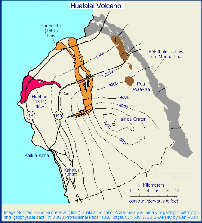Hualalai Volcano

Puu Waawaa trachyte pumice cone on Hualalai (photo by Scott Rowland)
(Much of the information in this document was derived from Moore et al., (1987) Hualalai Volcano: A preliminary summary of Geologic, Petrologic, and Geophysical data, In: Volcanism in Hawaii, USGS Professional Paper 1350, pages 571-585)
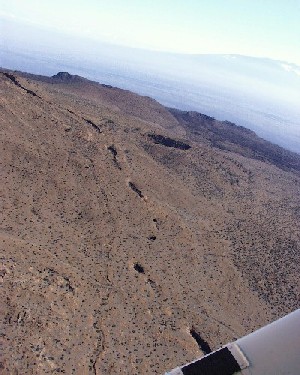 |
Two views of the Hualalai summit region from the air showing small craters and a collapsed lava tube.
Mauna Kea is in the distance (photos by Ken Rubin, flying by Jack Lockwood, breathing
exercises by Zinzuni Jurado Chichay)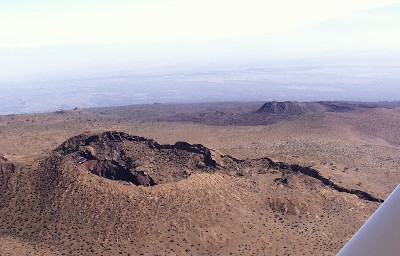
|
![]()
General Info
| Haulalai is a shield volcano located on the Big Island of Hawaii (19.69 N, 155.87 W). The summit of Hualalai rises to 2523m (8271ft) above sea level. The volcano is the westernmost of the 5 major Big Island volcanoes. It has a well-developed Northwest rift zone, a moderately well-developed South- | 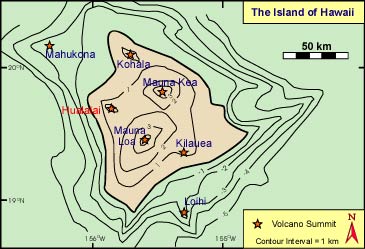
|
| Southeast rift zone, and a poorly developed North rift zone. The most recent eruption of 1800-1801 occurred along the Northwest rift zone. | |
Eruptive HistoryHaulalai has completed its main Tholeiitic Shield Stage, during which normal and picritic tholeiitic basalts were erupted. These lavas are no longer exposed on the subaerial surface but have been dredged from submarine portions of the northwest rift zone. Presently, the volcano is mantled by alkalic lavas erupted during the post-shield stage of volcanism (mostly alkali olivine basalts but rare occurrences of Trachyte are also present). The last historical eruption at Hualalai ended in 1801. It is considered to be the third most active volcano in Hawaii, after Mauna Loa and Kilauea |
|
The 1800-1801 eruption
Xenoliths
Hualalai is well-known in Hawaii as a good source for mantle xenoliths. The A.D. 1800 Kaupulehu flow on Hualalai volcano contains abundant coarse-grained xenoliths of exceptional size and quantity, and many prehistoric vent deposits and flows of this volcano also contain abundant xenoliths. A xenolith from the 1800-1801 flow is shown below.
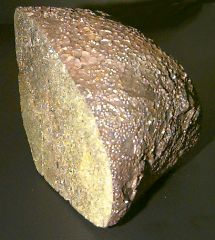
|
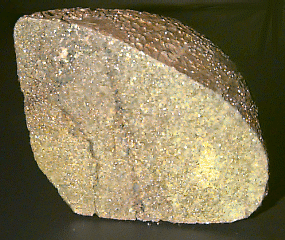
|
| These pictures show an example of an olivine-clinopyroxene bearing mantle xenolith from the 1800-1801 lava flow of Hualalai. A thin coating of host lava mantles the rock (image on right is about 15 cm wide) | |
Volcanic Hazards and Monitoring Although it has been 200
hundred years since the last eruption of Hualalai, it will almost certainly erupt
again. Lava flows by far pose the greatest danger in a potential future eruption
of Hualalai, because although explosive pyroclastic eruptions have occurred
during Holocene times (the past 10,000 years), they are relatively rare and
they cover only limited parts of the volcano. The alkalic eruptions at Hualalai
have been generally much less explosive than those at neighboring Kohala
and Mauna Kea volcanoes. There has been no recently-detected
magma-related seismicity or ground deformation at Hualalai, making it
difficult to say if and when the next eruption might occur.
| |
For additional information about Hualalai volcano, visit the USGS Hawaiian Volcano Observatory (Hualalai) page.
![]()

|

|

|

|
||
| HCV Home | Hawaiian Volcanoes | Loihi | Kilauea | Mauna Loa | Hualalai |
This page created by and maintained by Ken Rubin ©,
krubin@soest.hawaii.edu
Assisted by Brandon Doo, under the auspices of the Kailua High School
Community Quest work experience program
Other credits for this web site.
Volcano Quick Links
General Reference
Hawaiian volcano info:Links

